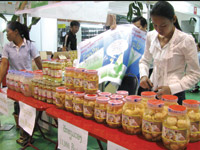Lao hydropower projects offer investment opportunities
Lao hydropower projects offer investment opportunities
Laos will continue to produce hydropower for export and offer investment opportunities in the power sector to further national development goals, a senior Lao official said at the Power & Electricity Thailand conference on Thursday.
Fourteen large-scale hydropower projects capable of producing a total of 3,199 MW are already in operation, eight more projects are under construction, and another 20 projects are in the final stage of preparation, Deputy Minister of Energy and Mines Viraphonh Viravong told industry experts in the Thai capital.
The largest hydropower project taking shape is the 1,260 MW Xayaboury plant, a public-private partnership involving Thai and Lao shareholders.
According to information from the Lao Ministry of Energy and Mines, Mr Viraphonh said investment opportunities exist in projects undergoing final stages of development and in 40 more projects that will be developed after 2020. Between 75 and 80 percent of Laos' energy production will be for export to Thailand, Vietnam, Cambodia and other nations in the region.
The deputy minister emphasised that Laos is committed to sustainable hydropower development and ensuring there will not be any significant cross-border impacts on the river system. It is a non-consumptive use of water, requires no fossil fuel, and is complementary to other renewable forms of energy and more complex sources like coal and nuclear power.
The responsible development of hydropower can bring millions of people out of poverty in Asia's less developed countries.
Large-scale hydropower comprises 33 percent of the natural capital of Laos' wealth, Mr Viraphonh said.
Electricity exports to Thailand began with Nam Ngum 1 dam in 1972. By 1993, the Nam Ngum 1 project alone had served more than 662,000 users in Thailand.
Designed as a 150 MW project, the Nam Ngum is still being expanded. “Another 40-megawatt unit is under implementation and may be expanded further to optimise the use of hydropower in the mix of the GMS grid,” he added.
Currently, the largest producing hydropower plant is the 1,086 MW Nam Theun. Completed in 2010, the project marked the return of international financiers to the business of funding large-scale hydropower in Laos. The World Bank regards it as a model of economic, environmental and social sustainability.
Among the other hydropower plants supplying clean, reliable, year-round energy to Thailand are the Theun-Hinboun, which last year doubled its installed capacity to 440 MW, and Xeset 1, which was optimised at 45 MW.
Laos faces many challenges in its quest to become the ‘battery of Asean', Mr Viraphonh said.
“Among the challenges are finding financial support, and meeting the environmental, conservation and sustainability standards that accompany the economic development of hydropower potential.”
Thai energy officials said 7 percent of the country's total electricity supply is imported from other countries, principally hydropower from Laos.
vientiane times














